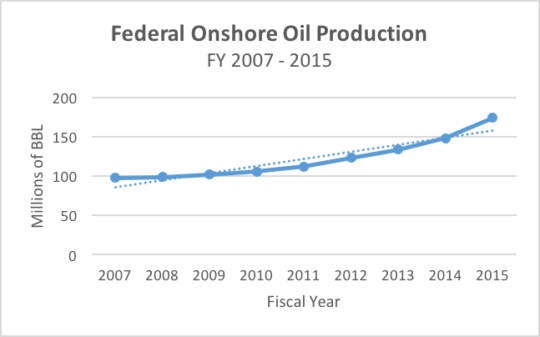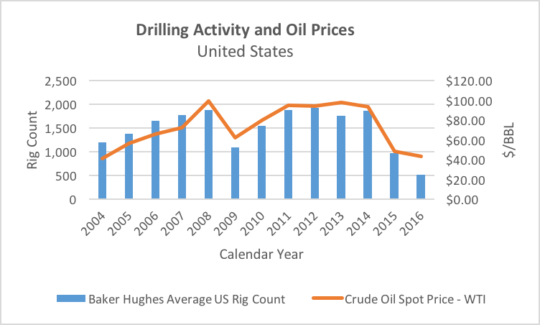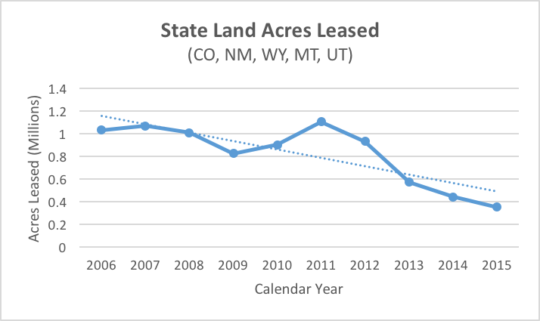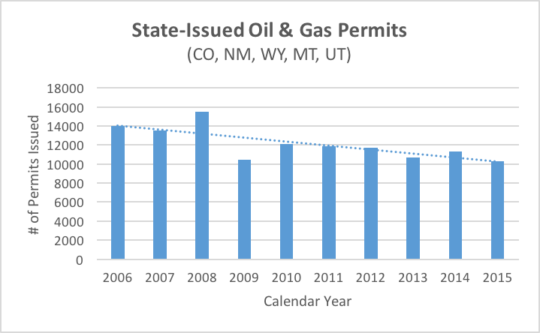Rigged: Industry’s real burden – low energy prices
Over the past few years, the oil and gas industry – aided by its army of lobbyists and millions of dollars in campaign donations – has spun a fabulous tale of oppressive rules and diminished access to federal lands. Yet, industry:
- Voluntarily passed on over 23 million acres of oil and gas leases offered for sale by BLM between 2009 and 2016;[1]
- Requested almost 7,000 fewer drilling permits between 2013 and 2015 than it did between 2007 and 2009; and
- Stubbornly refused to use the millions of acres of leases and thousands of drilling permits that it already owns.
If there were impediments to oil and gas production on federal lands – and it’s hard to say with a straight face that there actually were given that oil production on federal lands increased by 77% between 2008 and 2015 – they were related to market forces and the historic declines in oil and gas prices over the past few years.
Companies making business decisions in response to market conditions, including by slashing exploration and production budgets, should not be confused with purported onerous federal policies. Yet, that bait-and-switch is at the heart of industry’s efforts to undo common-sense protections for our national parks, wildlife, rivers and public lands.
Don’t believe us? Then listen to what industry is saying when its lobbyists are not on camera. When shareholders and regulators are demanding straight-talk, not rhetoric. What’s industry saying? It’s the economy, stupid.
It’s the Economy, Stupid.
It bears repeating, but only because industry likes to ignore this fundamental truth: drilling follows oil and gas prices. When prices go up (or down), drilling follows suit. This bedrock principle cuts across administrations and policy decisions:
While industry reflexively blames federal overreach for the perceived declines in leasing and permitting over the past few years, in truth, it was just industry reacting to the market. Had oil and gas prices not declined precipitously in recent years, then industry would likely have purchased some or all of the 23 million acres of leases that BLM offered, but it chose not to buy. At the very least, it certainly would have applied for more drilling permits. This, in turn, would have allowed leasing and permitting levels to hold steady.
Another important point that underscores the outsized role of the market: as oil and gas prices tanked in recent years, so did leasing and permitting on state lands. In fact, in 2015, western states leased 66 percent fewer lands than they did in 2006 and issued 26 percent fewer drilling permits. If federal overreach were the problem, then we wouldn’t expect to see the exact same trend on state lands. But that is, in fact, what we see.
Straight from the Horse’s Mouth.
As reported earlier this year, our country’s biggest oil and gas companies are telling their shareholders that federal policies are not materially affecting their bottom-line. So, what is then? If not “red tape,” then how is industry explaining to its shareholders that it’s passing on thousands of new leases and drilling permits? Let’s get it straight from the horse’s mouth – from some of the most active drillers on our public lands:
- EOG Resources: “[T]he substantial declines in crude oil, natural gas and NGL prices that began in 2014 and continued in 2015 and into 2016 materially and adversely affected the amount of cash flows we had available for our capital expenditures and other operating expenses and our results of operations during fiscal years 2015 and 2016.”
- Bill Barrett Corporation: “Oil prices declined significantly in 2014 and 2015 and remained depressed during 2016. In response, we suspended drilling activities in March 2016.”
- Devon Energy: “In the second half of 2014, global energy commodity prices began a rapid and significant decline, which continued through 2015 and into 2016. This commodity price decline adversely affected our business and results of operations and led to substantial impairments to our oil and gas properties during 2015 and 2016.”
- Noble Energy: “Average commodity prices for 2016 fell below the already suppressed 2015 average prices, and, thus, continued to negatively impact our revenues, operating cash flows and profitability and adversely affected the price of our common stock.”
- Halliburton: “The prolonged reduction in oil and natural gas prices depressed levels of exploration, development, and production activity in 2015 and 2016, and prolonged further reductions could have a material adverse effect on our business, consolidated results of operations, and consolidated financial condition.”
These are not hollow statements. Over the past three years, the largest lease-owners on our public lands have slashed – by nearly half – their capital expenditures, the bulk of which typically goes to lease acquisition, exploration and production.
| COMPANY [2] | CPTL. EXPEND. 2014 | CPTL. EXPEND. 2015 | CPTL. EXPEND. 2016 | %DECLINE 2014-16 |
| EOG Resources | $7.5 billion | $4.7 billion | $6.3 billion | 16% |
| ConocoPhillips | $7.6 billion | $5.1 billion | $2.1 billion | 72% |
| ExxonMobil | $9.4 billion | $7.8 billion | $3.5 billion | 63% |
| Anadarko Petroleum | $9.3 billion | $5.9 billion | $3.3 billion | 65% |
| BP | $23.5 billion | $19.5 billion | $19.4 billion | 17% |
| Devon Energy | $5.7 billion | $4.6 billion | $1.6 billion | 72% |
| Encana | $2.5 billion | $2.2 billion | $1.1 billion | 56% |
| Chevron | $35.4 billion | $29.5 billion | $18.1 billion | 49% |
| QEP Resources | $2.7 billion | $1.2 billion | $1.2 billion | 56% |
| Chesapeake Energy | $6.2 billion | $3.6 billion | $1.4 billion | 77% |
| Total | $109.8 billion | $84.1 billion | $58.0 billion | 47% |
While industry’s lobbyists continue to intentionally mislead the public about the role of federal policies, away from the spotlight, industry is telling a much different story. The market is, and will always be, the biggest factor that drives development on our public lands.
[1] Data for 2016 is available here: https://www.blm.gov/programs/energy-and-minerals/oil-and-gas/leasing.
[2] Where it was possible to include data for capital expenditures on domestic oil and gas exploration and production only, we did so.



